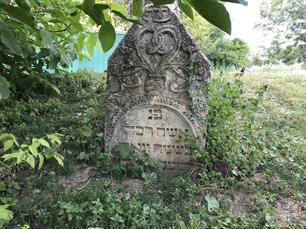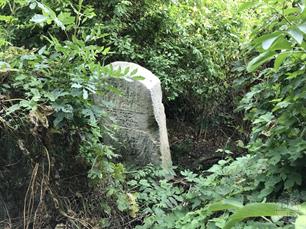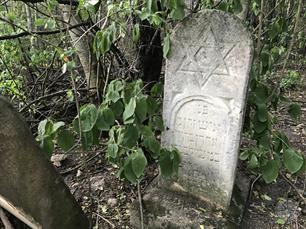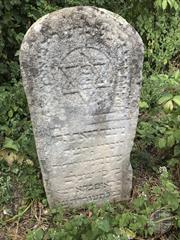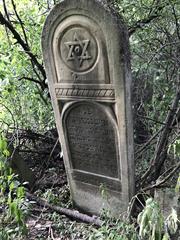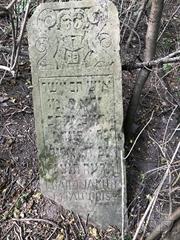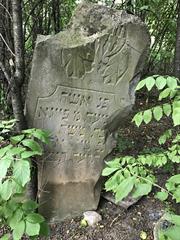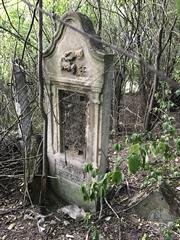Ulashkivtsi
Chortkiv district, Ternopil region
Sources:
- Pinkas Hakehillot Polin: Encyclopedia of Jewish Communities, Poland, Volume II, pages 54-55, published by Yad Vashem, Jerusalem. Translated by Jerrold Landau, JewishGen, Inc.
Photo:
- Hryhoriy Arshynov, European Jewish Cemeteries Initiative, 2019
- Center for Jewish Art New Jewish cemetery in Ulashkivtsi
- Pinkas Hakehillot Polin: Encyclopedia of Jewish Communities, Poland, Volume II, pages 54-55, published by Yad Vashem, Jerusalem. Translated by Jerrold Landau, JewishGen, Inc.
Photo:
- Hryhoriy Arshynov, European Jewish Cemeteries Initiative, 2019
- Center for Jewish Art New Jewish cemetery in Ulashkivtsi
Year - Total Population - Jews
1880 - 2,270 - 728
1900 - 2,280 - 489
1921 - 2,037 - 138
1880 - 2,270 - 728
1900 - 2,280 - 489
1921 - 2,037 - 138
In the 18th century, Ulaszkowce (now Ulashkivtsi, Улашківці) was a private town owned by the nobility, located 14 kilometers from the city of Czortkow (Chortkiv, Чортків) and situated on both banks of the Seret River. A Basilian Orthodox monastery was established in the town in 1720.
Zionist groups organized themselves in Ulaszkowce already during the final years of the 19th century. We have information on a Chanukah celebration in 1899 that was organized by the local Zion Organization, in which 300 people participated. At around that time, a Baron Hirsch school was founded in the town. After some time, a Hebrew supplementary school was founded in Ulaszkowce by the Safa Berurah. In 1906, 60 students studied there, mainly girls. The influence of the Zionists in Ulaszkowce is demonstrated by the facts that in this Hassidic town, a memorial for B. Z. Herzl took place in the synagogue in 1906, and that in 1905, 112 shekalim were sold locally. In 1911, we have information about the existence of a Mizrachi chapter in the town.
Zionist activity was renewed in Ulaszkowce after the First World War, and chapters of the Zionist organizations (General Zionists, Mizrachi, Hitachdut and the Revisionists) as well as chapters of the youth groups (Hanoar Hatzioni, Beitar, Hashachar, Achva, Akiva, Gordonia) were considered to be active in the region. The same situation existed with the Ezra chapter (established in 1923) and Hechalutz (established in 1924). A chapter of WIZO that was founded in 1936 was active in the area of education and assistance, aside from its cultural and publicity activities. Knitting courses and assistance for the local poor (care of the sick, and provision of food and clothing for those in need) were organized under its auspices. During the 1930s, a supplementary Hebrew school, affiliated with the Tarbut school network, existed in Ulaszkowce.
The shekel payers of Ulaszkowce voted as follows in the 1935 elections to the Zionist Congress: General Zionists – 261; Mizrachi – 57; the Working Land of Israel List – 188; the State Party (Mifleget Hamedina) – 77; and Hashachar – 60 votes.
During that era, the communal council was composed primarily of Zionists. In 1927, 5 Zionists, 1 representative of Yad Charutzim, and 2 unaffiliated delegates were elected to the town council. In 1933, the Zionists were once again the majority on the communal council; however due to the influence of the local rabbi, a Zionist was not chosen for the position of chairman of the council.
In 1933, 4 Jews, mainly Zionists, were elected to the city council from among the 12 seats. A number of the Jewish youth of Ulaszkowce were active in the illegal Communist Party or in its affiliated organizations. In 1936, Izak Shechter, the son of the shochet (ritual slaughterer) of Ulaszkowce was brought to judgment for Communist activity. In 1937, a Jew of Ulaszkowce was brought to judgment for collecting money for the Spanish Republic. In 1938, a Jewish young woman from Ulaszkowce was brought to judgment for Communist activity.
During the 1930s, signs of anti-Semitism increased in Ulaszkowce. Among other things, there were incidents of dismissal of Jews from their positions (in 1933, the Jewish workers in the local movie theater were fired); of propaganda (spreading of proclamations, calls for boycotts of Jewish business); and even incidents of breaking the windows of homes and beating Jews (in 1934, the windows of many Jewish homes were broken, including those of the home of the rabbi, who suffered a heart attack from the depth of emotion).
We are lacking information on the fate of the Jews of Ulaszkowce during the era of the Soviet rule (September 1939 – June 1941). Even information about the life of the Jewish community under the Nazi occupation is sparse and contradictory. In 1941, the Ukrainian residents perpetrated a pogrom against the Jews of Ulaszkowce and its environs, and pillaged their property. 68 people were murdered. The Jews who survived received threatening letters from the Ukrainians, commanding them to leave Ulaszkowce. They spread out through the cities of the region (Tluste, Czortkow, and others) and took the remnants of their property with them. In those cities, they met the same fate as the local Jewish population.
Jewish Ulaszkowce is perpetuated in the stories of the writer Sh. Y. Agnon.
Zionist groups organized themselves in Ulaszkowce already during the final years of the 19th century. We have information on a Chanukah celebration in 1899 that was organized by the local Zion Organization, in which 300 people participated. At around that time, a Baron Hirsch school was founded in the town. After some time, a Hebrew supplementary school was founded in Ulaszkowce by the Safa Berurah. In 1906, 60 students studied there, mainly girls. The influence of the Zionists in Ulaszkowce is demonstrated by the facts that in this Hassidic town, a memorial for B. Z. Herzl took place in the synagogue in 1906, and that in 1905, 112 shekalim were sold locally. In 1911, we have information about the existence of a Mizrachi chapter in the town.
Zionist activity was renewed in Ulaszkowce after the First World War, and chapters of the Zionist organizations (General Zionists, Mizrachi, Hitachdut and the Revisionists) as well as chapters of the youth groups (Hanoar Hatzioni, Beitar, Hashachar, Achva, Akiva, Gordonia) were considered to be active in the region. The same situation existed with the Ezra chapter (established in 1923) and Hechalutz (established in 1924). A chapter of WIZO that was founded in 1936 was active in the area of education and assistance, aside from its cultural and publicity activities. Knitting courses and assistance for the local poor (care of the sick, and provision of food and clothing for those in need) were organized under its auspices. During the 1930s, a supplementary Hebrew school, affiliated with the Tarbut school network, existed in Ulaszkowce.
The shekel payers of Ulaszkowce voted as follows in the 1935 elections to the Zionist Congress: General Zionists – 261; Mizrachi – 57; the Working Land of Israel List – 188; the State Party (Mifleget Hamedina) – 77; and Hashachar – 60 votes.
During that era, the communal council was composed primarily of Zionists. In 1927, 5 Zionists, 1 representative of Yad Charutzim, and 2 unaffiliated delegates were elected to the town council. In 1933, the Zionists were once again the majority on the communal council; however due to the influence of the local rabbi, a Zionist was not chosen for the position of chairman of the council.
In 1933, 4 Jews, mainly Zionists, were elected to the city council from among the 12 seats. A number of the Jewish youth of Ulaszkowce were active in the illegal Communist Party or in its affiliated organizations. In 1936, Izak Shechter, the son of the shochet (ritual slaughterer) of Ulaszkowce was brought to judgment for Communist activity. In 1937, a Jew of Ulaszkowce was brought to judgment for collecting money for the Spanish Republic. In 1938, a Jewish young woman from Ulaszkowce was brought to judgment for Communist activity.
During the 1930s, signs of anti-Semitism increased in Ulaszkowce. Among other things, there were incidents of dismissal of Jews from their positions (in 1933, the Jewish workers in the local movie theater were fired); of propaganda (spreading of proclamations, calls for boycotts of Jewish business); and even incidents of breaking the windows of homes and beating Jews (in 1934, the windows of many Jewish homes were broken, including those of the home of the rabbi, who suffered a heart attack from the depth of emotion).
We are lacking information on the fate of the Jews of Ulaszkowce during the era of the Soviet rule (September 1939 – June 1941). Even information about the life of the Jewish community under the Nazi occupation is sparse and contradictory. In 1941, the Ukrainian residents perpetrated a pogrom against the Jews of Ulaszkowce and its environs, and pillaged their property. 68 people were murdered. The Jews who survived received threatening letters from the Ukrainians, commanding them to leave Ulaszkowce. They spread out through the cities of the region (Tluste, Czortkow, and others) and took the remnants of their property with them. In those cities, they met the same fate as the local Jewish population.
Jewish Ulaszkowce is perpetuated in the stories of the writer Sh. Y. Agnon.

- Home
- Shtetls
- Vinnytsia region
- Volyn region
- Dnipro region
- Donetsk region
- Zhytomyr region
- Zakarpattia region
- Zaporizhzhia region
- Ivano-Frankivsk region
- Kyiv region
- Kropyvnytskyi region
- Luhansk region
- Lviv region
- Mykolayiv region
- Odessa region
- Poltava region
- Rivne region
- Sumy region
- Ternopil region
- Kharkiv region
- Kherson region
- Khmelnytskyi region
- Chernihiv region
- Chernivtsi region
- Cherkasy region
- Crimea
- Synagogues
- Cemeteries
- Objects & guides
- Gallery
- History
- Contact
Jewish towns of Ukraine
Jewish towns of Ukraine
My shtetl
My shtetl
Donate
